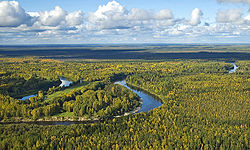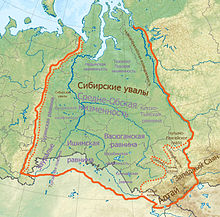West Siberian Plain
This article needs additional citations for verification. (July 2020) |
West Siberian Plain
Западно-Сибирская равнина | |
|---|---|
 View of the Vasyugan River | |
| Coordinates: 62°00′N 76°00′E / 62.000°N 76.000°E | |
| Location | Russia Kazakhstan |
| Part of | Siberia |
| Area | |
| • Total | 2,600,000 km2 (1,000,000 sq mi) |
| Dimensions | |
| • Length | 2,500 kilometers (1,600 mi) |
| • Width | 1,500 kilometers (930 mi) |


The West Siberian Plain (
Winters on the West Siberian Plain are harsh and long. The climate of most of the plain areas is either subarctic or continental. The plain had large petroleum and natural gas reserves. Most of Russia's oil and gas production was extracted from this area during the 1970s and 80s.[1]
Geography
The West Siberian Plain is located east of the
The long Yenisei river flows broadly south to north, a distance of 3,530 km (2,193 mi) to the Arctic Ocean, where it discharges more than 20 million litres (5 million gallons) of water per second at its mouth. Together with its tributary Angara, the two rivers flow 5,530 km (3,436 mi). The valley formed by the Yenisei acts as a rough dividing line between the West Siberian Plain and the
The West Siberian Plain is very
Flora and fauna
The plain has eight distinct vegetation regions: tundra, forest-tundra, northern taiga, middle taiga, southern taiga, sub-taiga forest, forest-steppe, and steppe. The number of animal species in the West Siberian Plain ranges from at least 107 in the tundra to 278 or more in the forest-steppe region. In the south of the plain, where permafrost is largely absent, rich grasslands that are an extension of the Kazakh Steppe formed the original vegetation, which had almost all been cleared by the early 21st century.
Geology
The West Siberian Plain consists mostly of
See also
- East European Plain, the other major plain of Russia
- Eurasian steppe
- South Siberian Mountains
- West Siberian petroleum basin
References
- ^ a b "Western Siberian Plain". Columbia Encyclopedia. Retrieved 2006-10-24.
- ^ "Russia". Encyclopædia Britannica. Retrieved 2006-10-24.
- ^ a b Physical Geography of the Soviet Union - West Siberian Plain
- A.M. Prokhorov- 3rd ed. 1969-1978.
- A.M. Prokhorov- 3rd ed. 1969-1978.
- A.M. Prokhorov. - 3rd ed. - M. Soviet Encyclopedia, 1969-1978. (in Russian)
- ^ The history of agricultural development of the Baraba Lowland
- ^ Flora of Salt Lakes of the Kulunda Plain (Southern Western Siberia)

